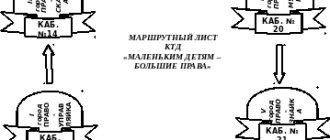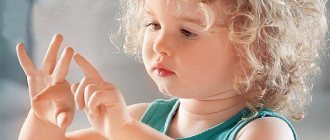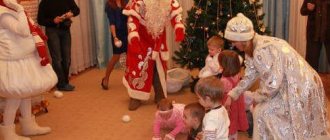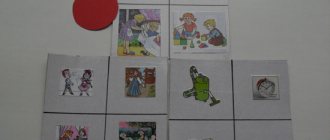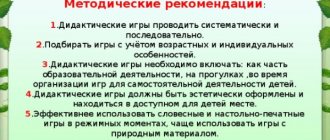Didactic games for children 3–4 years old
Chaenkova Galina
Didactic games for children 3–4 years old
1. Didactic game “Find the object”
Goal: learn to compare the shapes of objects with geometric patterns.
Material. Geometric shapes (circle, square, triangle, rectangle, oval)
.
Content.
Children stand in a semicircle. In the center there are two tables: on one there are geometric shapes, on the second there are objects. The teacher tells the rules of the game : “We will play like this: whoever the hoop rolls up to will come to the table and find an object with a mongrel of the same shape that I show. The child to whom the hoop rolled comes out, the teacher shows the circle and offers to find an object of the same shape. The found object rises high if it is chosen correctly, children. They clap their hands. Then the teacher rolls the hoop to the next child and offers a different shape. The game continues until all the objects are suitable and matched to the samples.
2. Didactic game “Funny Matryoshkas”
Goal: to teach to distinguish and compare objects according to different qualities of size.
Material. 2 sets of five-seater nesting dolls, 2 sets of circles of different sizes, a turret made of hollow cubes.
Content. At the invitation of the teacher, the children sit at a common table on which there is a nesting doll. The teacher turns to the children: “I want to play funny nesting dolls with you, but I see that there is only one nesting doll here, and where are the rest? (looks around, and then picks up a matryoshka doll and shakes it)
.
Something is rattling in the middle! Let's see what's there? (Removes the upper half of the matryoshka doll)
.
This turns out to be where they hid! (All nesting dolls are placed in a row)
.
Let's get to know them! The teacher calls the name of each nesting doll, tilting it: “I am Matryoshka, I am Natasha, I am Dasha, I am Masha,”
etc. Each child chooses one of the nesting dolls
(the teacher takes one matryoshka for himself)
.
The game begins. First, the nesting dolls walk (walk on the table)
.
Then they are called to measure height. They line up one after another and take turns, starting with the smallest, stand according to height, and the teacher clarifies which nesting doll is the smallest (tall? Then the nesting dolls go to lunch. The teacher puts on the table a set of circles (plates)
of five sizes, calls
the children according to queues , who select plates of the appropriate size for their nesting dolls. After lunch, the nesting dolls get ready for a walk. The teacher puts a second set of nesting dolls on the table, and the children select girlfriends for their nesting dolls of the same height. Pairs of nesting dolls move around the table. Then they scatter and mix. ( “Matryoshka” wanted to run
." Unnoticed by
the children , the teacher removes a pair of nesting dolls of the same height from the table. “It’s time to go home!” says the teacher.
Get into pairs." call the nesting dolls by name
(if they remember)
. Everyone asks her in unison to come back. The dolls appear, the kids put them in their place and the toys go home.
The teacher puts on the table a tower made of hollow cubes (one side is missing)
- these are houses for nesting dolls. At the request of the teacher, each child finds a home for his nesting doll. The nesting dolls bow, say goodbye and go home.
3. Didactic game “Long - short”
Goal: to develop in children a clear differentiated perception of new qualities of size.
Material. Satin and nylon ribbons of different colors and sizes, cardboard strips, story toys: a fat bear and a thin doll.
Content.
Before the game , the teacher lays out sets of gaming didactic material (multi-colored ribbons, stripes)
.
The teacher takes out two toys - a teddy bear and a Katya doll. He tells the children that Misha and Katya want to be dressed up today, and for this they need belts. He calls two children and gives them ribbons rolled into a tube: one short - a belt for Katya, the other long - a belt for a bear.
Children, with the help of a teacher, try on and tie belts on toys. The toys express joy and bow. But then the toys want to change belts. The teacher offers to remove the belts and change their toys. Suddenly he discovers that the belt on the Kuklin bear does not fit, and the belt is too big for the doll. The teacher offers to examine the belts and spreads them side by side on the table, and then places a short ribbon on top of a long one. He explains which ribbon is long and which is short, i.e. he gives the name for the quality of quantity - length. After this, the teacher shows the children two cardboard strips - a long one and a short one. Shows children how to compare strips with ribbons by overlapping them and tell which one is short and which one is long.
4. Game “Right as Left”
Goal: mastering the ability to navigate on a sheet of paper.
Content. The nesting dolls were in a hurry and forgot to complete their drawings. You need to finish drawing them so that one half is similar to the other. The children draw, and the adult says: “Dot, dot, two hooks, minus a comma - it’s a funny face.” And if there is a bow and a little skirt, the man is a girl. And if he has a forelock and shorts, that little man is a boy.” Children look at the drawings."
5. Didactic game “Pick a figure”
Goal: to consolidate children’s about geometric shapes and practice naming them.
Material. Demonstration: circle, square, triangle, oval, rectangle, cut out of cardboard.
Handout: cards with outlines of 5 geometric lottos.
Content.
The teacher shows the children the figures, traces each with a finger. Gives the children a task: “You have cards on your tables with figures of different shapes on them, and the same figures on trays. Place all the figures on the cards so that they are hidden.” Asks the children to trace each figure lying on the tray, and then overlays ( "hide"
) it onto the drawn figure.
6. Didactic game “Three squares”
Goal: to teach children to correlate three objects by size and indicate their relationship with the words: “big”
, small”,
“medium”
, largest”,
“smallest”
.
Material. Three squares of different sizes, flannelgraph; Children have 3 squares , flannelgraph.
Content.
Educator: Children, I have 3 squares, like these (shows)
.
This one is the biggest, this one is smaller, and this one is the smallest (each of them shows)
. Now show the largest squares (children pick them up and show them, put them down. Now raise the middle ones. Now the smallest ones.
Next, the teacher invites the children to build towers from the squares. He shows how this is done - he places first a large, then a medium, then a small square on the flannelgraph from bottom to top. “Make such a tower on your flannelographs,” says the teacher.
7. Geometric Lotto
Goal: to teach children to compare the shape of the depicted object with a geometric figure and to select objects according to a geometric pattern.
Material: 5 cards each with images of geometric shapes: 1 circle, square, triangle, rectangle, oval. 5 cards each with images of objects of different shapes: round (tennis ball, apple, ball, soccer ball, balloon, square rug, scarf , cube, etc.; oval (melon, plum, leaf, beetle, egg)
;
rectangular (envelope, briefcase, book, domino, picture)
.
Content.
children take part . The teacher reviews the material with the children. Children name figures and objects. Then, according to the instructions of the teacher, they select cards with images of objects of the desired shape for their geometric samples. The teacher helps children correctly name the shape of objects (round, oval, square, rectangular)
.
8. Didactic game “What kinds of shapes are there?”
Goal: to introduce children to new shapes : oval, rectangle, triangle, giving them in pairs with already familiar ones: square-triangle, square-rectangle, circle-oval.
Material. Doll. Demonstration: large cardboard figures: square, triangle, rectangle, oval, circle. Handout: 2 figures of each smaller shape.
Content.
The doll brings figures. The teacher shows the children a square and a triangle and asks what the first figure is called. Having received an answer, he says that there is a triangle in the other hand. The examination is carried out by tracing the contour with a finger. Draws attention to the fact that a triangle has only three angles. Invites children to pick up triangles and put them together. Similarly: a square with a rectangle, an oval with a circle.
9. Didactic game “Let’s collect beads”
Goal: to develop the ability to group geometric shapes according to two properties (color and shape, size and color, shape and size, to see the simplest patterns in the alternation of shapes.
Equipment. There is a long ribbon on the floor, on which figures are laid out from left to right in a certain alternation: red triangle, green circle, red triangle, etc.
Children stand in a circle, in front of them are boxes with multi-colored geometric shapes.
Progress of the game . The teacher offers to make beads for the New Year tree. He points to a ribbon with laid out geometric shapes and says: “Look, the Snow Maiden has already started making them. What shapes did she decide to make the beads from? Guess which bead is next.” Children take two of the same figures, name them and begin to make beads. They explain why they lay out this particular figure. Under the guidance of the teacher, mistakes are corrected.
Then the teacher says that the beads have scattered and need to be collected again. He lays out the beginning of the beads on the tape, and invites the children to continue. He asks which figure should be next and why. Children choose geometric shapes and arrange them in accordance with a given pattern.
10. Didactic game “Wide - Narrow”
Goal: to form a “broad - narrow”
.
Content.
The lesson is carried out in a similar way, but now children learn to distinguish the width of objects, i.e. wide and narrow ribbons of the same length. When creating a game situation, you can use the following game technique. Two cardboard strips are laid out on the table - wide and narrow (of the same length)
.
along a wide strip (path)
, but only one of them can walk along a narrow strip. Or you can play the story with two cars
11. Didactic game “Who needs what uniform”
Option. No. 1.
Purpose: to teach children to group geometric shapes (ovals, circles)
in shape, ignoring color and size.
Material. Large bear and matryoshka. Handout: three circles and ovals of different colors and sizes, 2 large trays for each child.
Content.
The teacher demonstrates a circle and an oval, asks the children to remember the names of these figures, show how they differ from each other, and trace the contours with their fingers. “Now put all the circles on one tray for a matryoshka, all the ovals and another for a bear.” The teacher observes how the children complete the task, and in case of difficulty, invites the child to circle the figure with his finger and say what it is called.
At the end of the lesson, the teacher summarizes: “Today we learned to distinguish circles from ovals. The bear will take all the ovals to the forest, and the matryoshka will take the circles home.
12. Didactic game “Our Day”
Goal: to consolidate the idea of the parts of the day, to teach how to correctly use the words “morning”
,
“day”
,
“evening”
,
“night”
.
Equipment. Bibabo doll, toy bed, dishes, comb, etc.; pictures showing children's at different times of the day.
Progress of the game . Children sit in a semicircle. The teacher, with the help of a doll, performs various actions by which children must determine the part of the day: the doll gets out of bed, gets dressed, combs its hair (morning, lunch (day)
etc. Then the teacher names the action, for example:
“The doll washes itself
,” invites the child to perform it and name the part of the day corresponding to this action
(morning or evening)
. The teacher reads an excerpt from poems by Petrushina:
Doll Valya wants to sleep.
I'll put her to bed.
I'll bring her a blanket
To fall asleep faster
Children put the doll to sleep and say when this happens. The teacher shows pictures in time sequence and asks what part of the day these actions occur. Then he mixes the pictures and, together with the children, places them in the order of the actions of the day. Children arrange their pictures in accordance with the teacher's pictures.
13. Didactic game “Make an object”
Purpose: to practice drawing up the silhouette of an object from individual parts (geometric shapes)
.
Equipment. On the teacher’s table there are large toys: a house, a tumbler, a snowman, a Christmas tree, a truck. There are sets of different geometric shapes on the floor.
Progress of the game . The teacher offers to name the toys that are on his table and make any of them using a set of geometric shapes. Encourages and stimulates children's . Asks: “What did you make up? From what geometric shapes?
. Children examine the resulting silhouettes of toys, remember the corresponding poems and riddles.
It is possible to combine the composed silhouettes into a single plot: “House in the Forest”
,
“Winter Walk”
,
“Street”
14. Didactic game “Learn and Remember”
Goal: to teach children to remember what they perceive, to make choices based on presentation.
Equipment. Cards depicting three single-color geometric shapes (circle, square, triangle; circle, oval, square, etc., a set of small cards depicting one shape to be placed on large cards.
Progress of the game . In front of the child is a card with a picture of 3 shapes. The teacher asks to look at it and remember what shapes are drawn there. Then he gives the children sheets of paper and asks them to cover their cards with them. After that, he shows a small card. puts it face down on the table, mentally counts to 15, asks the children to take off the paper and show on their cards the same shape that he demonstrated. To check, the teacher again shows the sample card.
DEVELOPING MEMORY
SHOP
Give your child the task of going to a virtual store and buying a number of products and things. Each time you send it to the store, increase the list. If he brought the wrong thing or forgot something, it is important to help him with leading questions.
MEMORY NOTE
We arrange different objects in a row. The child must remember their location, and you must either remove the object or swap the objects with each other. The child will have to indicate what has changed in the row.
ARTIST
Draw a simple pattern with it. Let him take a good look at it. Then remove the picture and ask him to reproduce it himself. You can use ready-made patterns from the Little Designer set.
Of course, games based on the famous principle of “Memo” and Mimi “Memo” are suitable for developing the baby’s memory.
A wide selection of didactic games in the Big Book on Memory Development.
EXPLORING THE WORLD AROUND
Now you can instill in your child a love of nature, teach him how to care for it, and develop a sense of responsibility and compassion. To make it easier for the baby to accept himself as a whole with the world around him, you need to help him navigate time, know the causes and consequences of natural phenomena. Environmental games will help increase your child’s knowledge:
NATURE CALENDAR
This game is for every day. Every morning you can ask your child to look out the window and note what natural phenomena he sees. Are there clouds in the sky? Is it raining? Is the wind blowing? Let the baby remember what time of year it is. Then go back to the calendar and mark everything you saw in the special fields. Help your child identify the month and day of the week. If you do this for a long time every day, the baby will easily remember their names.
MINI-GAMES “TREES”
This game can be continued in nature, picking up fallen leaves and cones and guessing which tree they come from.
"TALES ABOUT ANIMALS"
"GUESS WHAT YOU ATE"
The game uses a taste analyzer, reinforcing the concepts of fruits and vegetables, what grows where. First, fruits or vegetables are cut into small pieces, then the child’s eyes are closed and allowed to taste, the baby must guess what he ate.
"WHO LIVES WHERE?"
"WHO EATS WHAT"
Here you can use the “harmful thing” that children at this age like to show off. Invite your child to play “Confusion” by incorrectly distributing treats to animals. Ask your child how a cat might feel when it gets acorns. Maybe he was upset? How does the bear feel when he receives cabbage? Angry? Try to portray these emotions together.
CUBES "ATLAS OF THE WORLD"
Talk to your child about what he sees in each collected picture. Tell us about the peoples who are depicted in different parts of the world, why they have different skin colors and different costumes. Show the main attractions of each area. Tell your child how great it is when there are so many different interesting people, beautiful places, amazing animals. Help your child feel the beauty of the world and its diversity.
"ABOUT SPACE"
EXPANDING VOCABULARY
“TELL WHAT?”
Different objects are placed in the box, the child takes them out one by one and names the signs.
“WHO CAN DO WHAT?”
The game “What kind of profession” is suitable for this. The baby is called an object, an animal, a person (profession), and he must answer what he can do.
“WHAT’S IN THE BAG?”
We will need a “Sensory Bag”. In a small bag you need to place objects that differ in shape and size and feel different to the touch. The child, closing his eyes, should try to determine what exactly came into his hands.
We introduce the child to three-dimensional geometric shapes: cube, ball, cone, etc.
The same figures can be used for a tactile bag.
KALEIDOSCOPE
We admire the patterns in the kaleidoscope, expressing emotions: “Beautiful!”, “Extraordinary!”, “Wonderful!”
PREPOSITION LEARNING GAME
We learn prepositions with the game.


